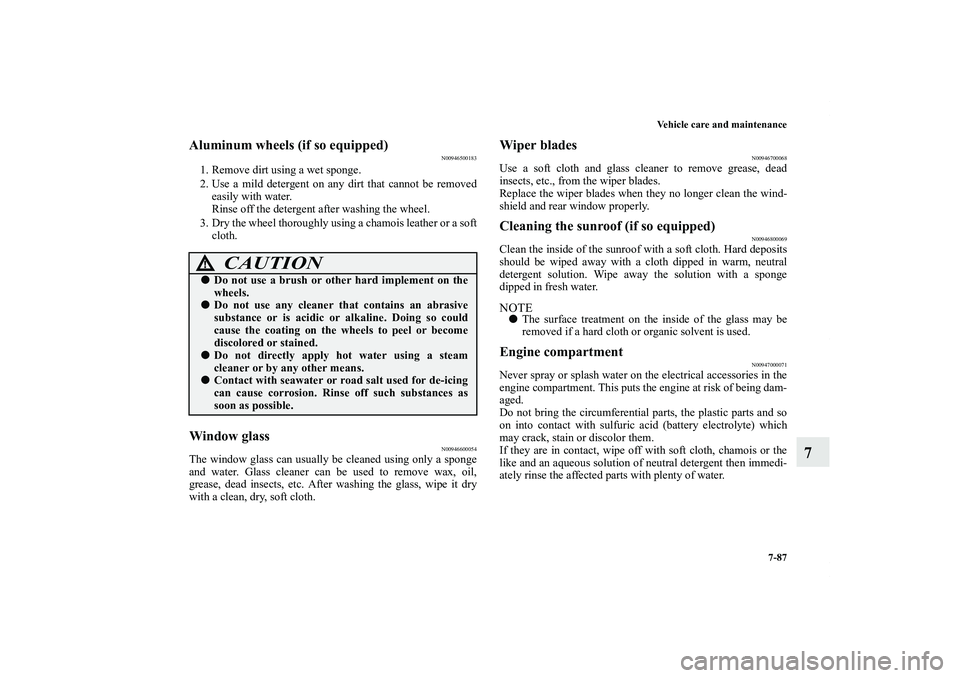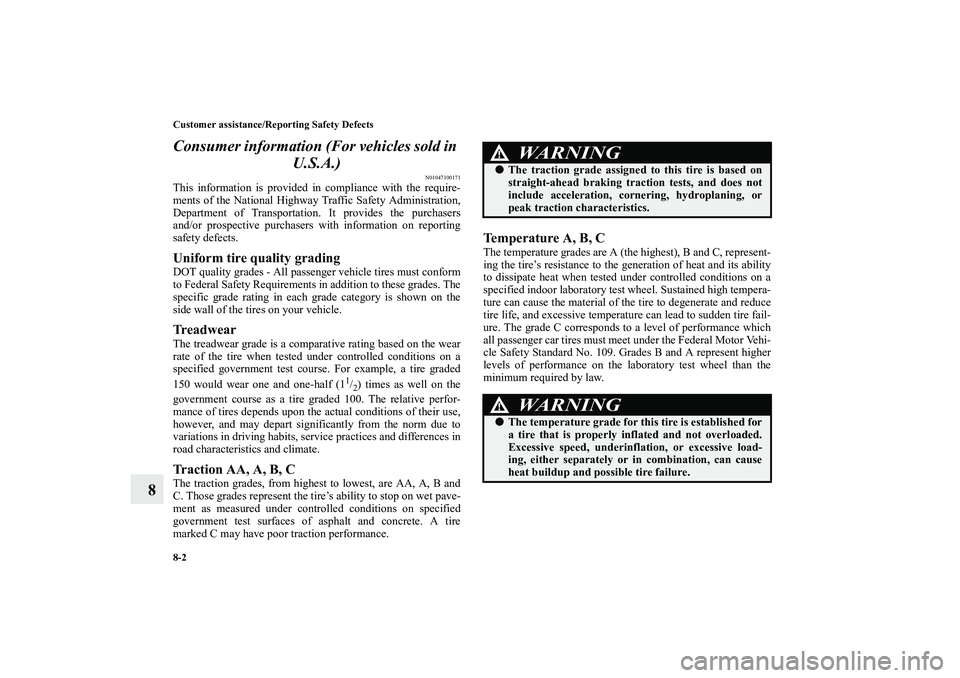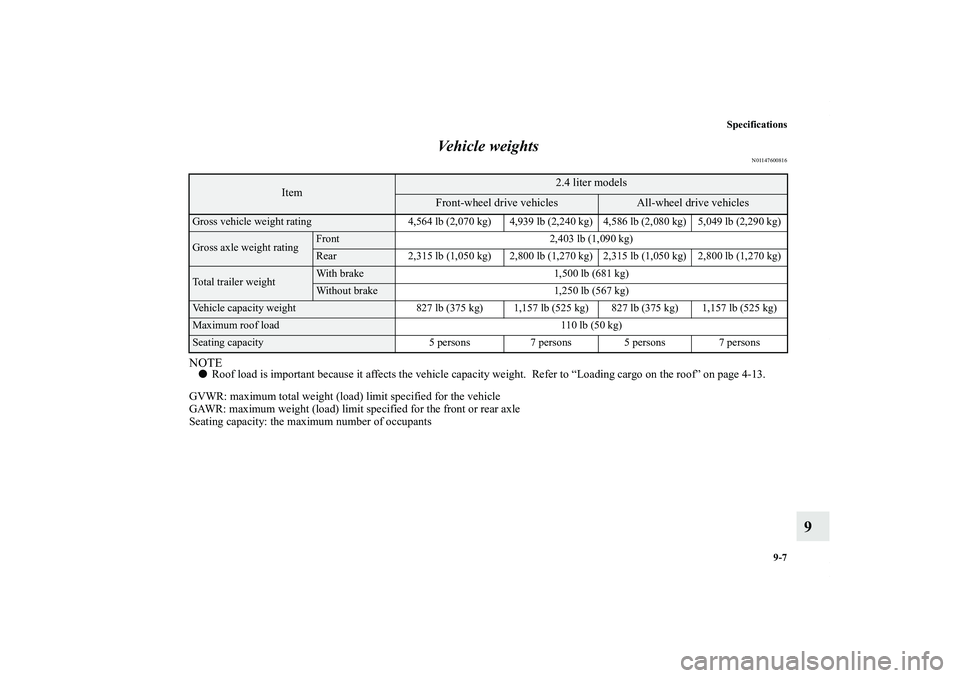Page 684 of 714

Vehicle care and maintenance
7-87
7
Aluminum wheels (if so equipped)
N00946500183
1. Remove dirt using a wet sponge.
2. Use a mild detergent on any dirt that cannot be removed
easily with water.
Rinse off the detergent after washing the wheel.
3. Dry the wheel thoroughly using a chamois leather or a soft
cloth.Window glass
N00946600054
The window glass can usually be cleaned using only a sponge
and water. Glass cleaner can be used to remove wax, oil,
grease, dead insects, etc. After washing the glass, wipe it dry
with a clean, dry, soft cloth.
Wiper blades
N00946700068
Use a soft cloth and glass cleaner to remove grease, dead
insects, etc., from the wiper blades.
Replace the wiper blades when they no longer clean the wind-
shield and rear window properly.Cleaning the sunroof (if so equipped)
N00946800069
Clean the inside of the sunroof with a soft cloth. Hard deposits
should be wiped away with a cloth dipped in warm, neutral
detergent solution. Wipe away the solution with a sponge
dipped in fresh water.NOTE�The surface treatment on the inside of the glass may be
removed if a hard cloth or organic solvent is used.Engine compartment
N00947000071
Never spray or splash water on the electrical accessories in the
engine compartment. This puts the engine at risk of being dam-
aged.
Do not bring the circumferential parts, the plastic parts and so
on into contact with sulfuric acid (battery electrolyte) which
may crack, stain or discolor them.
If they are in contact, wipe off with soft cloth, chamois or the
like and an aqueous solution of neutral detergent then immedi-
ately rinse the affected parts with plenty of water.
CAUTION
!�Do not use a brush or other hard implement on the
wheels.�Do not use any cleaner that contains an abrasive
substance or is acidic or alkaline. Doing so could
cause the coating on the wheels to peel or become
discolored or stained.�Do not directly apply hot water using a steam
cleaner or by any other means.�Contact with seawater or road salt used for de-icing
can cause corrosion. Rinse off such substances as
soon as possible.
BK0122500US.book 87 ページ 2010年5月12日 水曜日 午前11時11分
Page 687 of 714

8-2 Customer assistance/Reporting Safety Defects
8Consumer information (For vehicles sold in
U.S.A.)
N01047100171
This information is provided in compliance with the require-
ments of the National Highway Traffic Safety Administration,
Department of Transportation. It provides the purchasers
and/or prospective purchasers with information on reporting
safety defects. Uniform tire quality gradingDOT quality grades - All passenger vehicle tires must conform
to Federal Safety Requirements in addition to these grades. The
specific grade rating in each grade category is shown on the
side wall of the tires on your vehicle. Treadwear The treadwear grade is a comparative rating based on the wear
rate of the tire when tested under controlled conditions on a
specified government test course. For example, a tire graded
150 would wear one and one-half (1
1/2) times as well on the
government course as a tire graded 100. The relative perfor-
mance of tires depends upon the actual conditions of their use,
however, and may depart significantly from the norm due to
variations in driving habits, service practices and differences in
road characteristics and climate.
Traction AA, A, B, C The traction grades, from highest to lowest, are AA, A, B and
C. Those grades represent the tire’s ability to stop on wet pave-
ment as measured under controlled conditions on specified
government test surfaces of asphalt and concrete. A tire
marked C may have poor traction performance.
Temperature A, B, CThe temperature grades are A (the highest), B and C, represent-
ing the tire’s resistance to the generation of heat and its ability
to dissipate heat when tested under controlled conditions on a
specified indoor laboratory test wheel. Sustained high tempera-
ture can cause the material of the tire to degenerate and reduce
tire life, and excessive temperature can lead to sudden tire fail-
ure. The grade C corresponds to a level of performance which
all passenger car tires must meet under the Federal Motor Vehi-
cle Safety Standard No. 109. Grades B and A represent higher
levels of performance on the laboratory test wheel than the
minimum required by law.
WA R N I N G
!�The traction grade assigned to this tire is based on
straight-ahead braking traction tests, and does not
include acceleration, cornering, hydroplaning, or
peak traction characteristics.
WA R N I N G
!�The temperature grade for this tire is established for
a tire that is properly inflated and not overloaded.
Excessive speed, underinflation, or excessive load-
ing, either separately or in combination, can cause
heat buildup and possible tire failure.
BK0122500US.book 2 ページ 2010年5月12日 水曜日 午前11時11分
Page 692 of 714
9
Specifications
Vehicle labeling . . . . . . . . . . . . . . . . . . . . . . . . . . .9- 2
Vehicle dimensions . . . . . . . . . . . . . . . . . . . . . . . .9- 6
Vehicle weights . . . . . . . . . . . . . . . . . . . . . . . . . . .9- 7
Engine specifications . . . . . . . . . . . . . . . . . . . . . . .9- 9
Battery . . . . . . . . . . . . . . . . . . . . . . . . . . . . . . . . . .9- 10
Tires and wheels. . . . . . . . . . . . . . . . . . . . . . . . . . .9- 10
Capacity . . . . . . . . . . . . . . . . . . . . . . . . . . . . . . . . .9- 11
BK0122500US.book 1 ページ 2010年5月12日 水曜日 午前11時11分
Page 697 of 714
9-6 Specifications
9Vehicle dimensions
N01147500453
Overall length 183.7 in (4,665 mm)Overall width 70.9 in (1,800 mm)Overall height
Without roof rails 66.1 in (1,680 mm)With roof rails 67.7 in (1,720 mm)
Wheel base 105.1 in (2,670 mm)BK0122500US.book 6 ページ 2010年5月12日 水曜日 午前11時11分
Page 698 of 714

Specifications
9-7
9 Vehicle weights
N01147600816
NOTE�Roof load is important because it affects the vehicle capacity weight. Refer to “Loading cargo on the roof” on page 4-13.
GVWR: maximum total weight (load) limit specified for the vehicle
GAWR: maximum weight (load) limit specified for the front or rear axle
Seating capacity: the maximum number of occupants
Item
2.4 liter models
Front-wheel drive vehicles
All-wheel drive vehicles
Gross vehicle weight rating 4,564 lb (2,070 kg) 4,939 lb (2,240 kg) 4,586 lb (2,080 kg) 5,049 lb (2,290 kg)Gross axle weight rating
Front 2,403 lb (1,090 kg)Rear 2,315 lb (1,050 kg) 2,800 lb (1,270 kg) 2,315 lb (1,050 kg) 2,800 lb (1,270 kg)
Total trailer weight
With brake 1,500 lb (681 kg)Without brake 1,250 lb (567 kg)
Vehicle capacity weight 827 lb (375 kg) 1,157 lb (525 kg) 827 lb (375 kg) 1,157 lb (525 kg)Maximum roof load 110 lb (50 kg)Seating capacity 5 persons 7 persons 5 persons 7 persons
BK0122500US.book 7 ページ 2010年5月12日 水曜日 午前11時11分
Page 699 of 714
9-8 Specifications
9
NOTE�Roof load is important because it affects the vehicle capacity weight. Refer to “Loading cargo on the roof” on page 4-13.
GVWR: maximum total weight (load) limit specified for the vehicle
GAWR: maximum weight (load) limit specified for the front or rear axle
Seating capacity: the maximum number of occupants
Item
3.0 liter models
Front-wheel drive vehicles
All-wheel drive vehicles
Gross vehicle weight rating 4,696 lb (2,130 kg) 5,071 lb (2,300 kg) 4,696 lb (2,130 kg) 5,181 lb (2,350 kg)Gross axle weight rating
Front 2,403 lb (1,090 kg)Rear 2,315 lb (1,050 kg) 2,800 lb (1,270 kg) 2,315 lb (1,050 kg) 2,800 lb (1,270 kg)
Total trailer weight
With brake 2,000 lb (907 kg) 3,500 lb (1,588 kg)Without brake 1,400 lb (635 kg)
Vehicle capacity weight 935 lb (424 kg) 1,157 lb (525 kg) 935 lb (424 kg) 1,157 lb (525 kg)Maximum roof load 110 lb (50 kg)Seating capacity 5 persons 7 persons 5 persons 7 personsBK0122500US.book 8 ページ 2010年5月12日 水曜日 午前11時11分
Page 701 of 714
9-10 Specifications
9Battery
N01147800225
Battery is a 12 volt type.
Tires and wheels
N01147900662
PCD: Pitch Circle Diameter (installation holes)NOTE�Contact an authorized Mitsubishi Motors dealer for details
on the combination used on your vehicle.
�These tires satisfy vehicle loading conditions described in
this owner’s manual.
2.4 liter 75D23L3.0 liter 80D26L
Tire P215/70R16 99H P225/55R18 97HWheel
Size 16 x 6 1/2JJ 18 x 7JPCD 4.5 in (114.3 mm)Offset 1.5 in (38 mm)
BK0122500US.book 10 ページ 2010年5月12日 水曜日 午前11時11分
Page 702 of 714

Specifications
9-11
9 Capacity
N01148000918
Item
Capacity
Lubricants
Fuel
(approximate)
Front-wheel drive vehicles 16.6 gal (63 L)
Refer to “Fuel selection” on page 1-2All-wheel drive vehicles 15.8 gal (60 L)
Engine oil
2.4 liter
Oil pan 4.5 qt (4.3 L)
Engine oils displaying the ILSAC certification mark (“star-
burst” symbol) on the container.
If these oils are not available, and API classification SM
can be used.Oil filter .32 qt (0.3 L)
3.0 liter
Oil pan 4.2 qt (4.0 L)Oil filter .32 qt (0.3 L)
Power steering As required Genuine Mitsubishi Power Steering FluidAutomatic transaxle 8.7 qt (8.2 L) Dia queen ATF - J3Continuously variable transmission (CVT) 7.5 qt (7.1 L) Dia queen CVTF - J1Transfer oil .52 qt (0.49 L) Hypoid gear oil API classification GL-5 SAE 80Differential
Rear axle .53 qt (0.5 L) Hypoid gear oil API classification GL-5 SAE 80
Brake As required Conforming to Brake fluid DOT3 or DOT4Hood lock release mechanism and safety catch As required Multipurpose type grease NLGI Grade 2Engine coolant
{Includes .69 qt
(0.65 L) in
reserve tank}
Automatic transaxle 10.0 qt (9.5 L)
Dia Queen Super Long Life Coolant
Premium or equivalent*CVT 7.9 qt (7.5 L)
Washer fluid 4.8 qt (4.5 L) —Refrigerant (air conditioning)Refer to the “Air
conditioning label”
on page 9-2.HFC-134a
BK0122500US.book 11 ページ 2010年5月12日 水曜日 午前11時11分